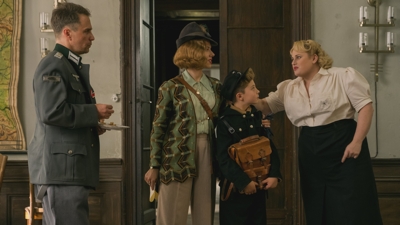Grade: C-
Horror/Drama
Not rated (would be PG)
Just in time for Halloween, Film Masters has released a B-movie trick or treat (you decide): a newly restored 4K scan from 35mm archival materials of the Gene and Roger Corman-produced Beast from Haunted Cave Special Edition. What makes it a special edition is bonus B movie from the King of B Movies, director Roger Corman: his WWII drama Ski Troop Attack, with both films released in 1959.
The Corman brothers were ahead of his time, because their films are perfect for today’s young adult film-watching parties, where the goal is to offer snarky running commentaries. It will be a “treat” for this crowd to savor and skewer—especially the “beast,” who has to be a contender for worst looking bargain-basement movie monster ever. You’ve got to see this. Really.
The “trick,” of course, is that the film got a 4.3 rating out of 10 at IMDB.com, and that’s not inaccurate. But a little context:
As someone who grew up in the late fifties and early sixties, I’ve sat through my share of B movies when going to the theater meant a double feature: the heavily advertised A movie that you went there to see, and a B movie that was shot on the cheap and thrown in as a bonus. Most of them were genre films and some of them were just bad. Sad bad—the kind that made you squirm in your seat or think to go to the restroom yet again, because you had a limited amount of money for movie snacks and could only make so many trips to the lobby counter. Then there were Hammer films and Roger Corman films, who embraced the fact that they were making movies, not films, on the cheap, so why not do it tongue in cheek? These were the campy films, the so-bad-they’re-good ones that left you wondering whether they were intentionally or unintentionally goofy. Somehow, despite being bad and having abrupt endings that made you wonder if they stopped filming when the money ran out, they were still fun to watch.
That’s what we’re dealing with here. Beast from Haunted Cave combines two genres—the heist film and the horror film—and it ends so suddenly that—wait, what?—you’ll probably want to rewind a bit. The plot is straightforward, as B movies typically are, but with better-than-B-average dialogue. A group of men and one woman plan on robbing a ski lodge, and decide to blow up an old mine/cave for a distraction. There’s more talk than action, but there are some interesting moments, many of them provided when Sheila Carol is on camera. Trivia fans might also look for Frank Sinatra’s nephew, who does a decent job with his role.
The heist team in this film is probably the most generic and benign cast of characters ever assembled, though the writing and their acting is just good enough to hold your attention until the next sighting of a creature that sometimes looks like a hairy tentacle operated by a Muppetteer and sometimes looks like a thinner, gauzy, spidery rendition of Pizza the Hutt. Like I said, you’ve got to see this movie monster to believe it. Beast from Haunted Cave is one of those B movies that’s fun make fun of.
Ski Troop Attackis surprisingly okay for a B movie, which is to say it’s almost good. Like Beast, it holds your attention while you wait for something to happen, but instead of hokey laughable moments there are just logical lapses that make you think, really? Like, why is it that it takes five ski troopers behind enemy lines to take out a bridge that we’re told can’t be attacked by the air, when A movies like 633 Squadron and The Bridges at Toko-Ri established that pretty much any target can be hit through the air?
Both films are halfway decent for B movies, and the transfers look great. Of the two, Beast remains the most fun to watch because of that campy monster. Ski Troop Attack, also filmed in Deadwood and the Black Hills of South Dakota, doesn’t lend itself as much to wisecracks—maybe because a historical war is the central subject. As I said, it’s surprisingly okay, but logically uneven. One final note: like Alfred Hitchcock, Roger Corman liked to insert himself into his films. Look for “German Soldier Entering Cabin” in this one. The films and bonus features are on two separate discs in this release.
Entire family: No (Age 10 and older)
Run times: 65 and 72 min., Black & White
Studio/Distributor: Film Masters
Aspect ratios: 1.85:1 and 1.33:1
Featured audios: Dolby Digital and DTS 2.0 Mono
Bonus features: B-/C+
Not rated (would be PG for adult subjects and frightening images)
Language: 2/10—Beast is squeaky clean, and Ski Troop isn’t much worse
Sex: 1/10—Other than a single bathtub scene where nothing can be seen, there isn’t anything here
Violence: 3/10—Neither film is particularly violent, either
Adult situations: 4/10—Some smoking and drinking and wartime action
Takeaway: This is an interesting pairing of a Corman brothers’ produced B movie and a Roger Corman directed movie






















